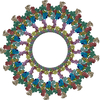+Search query
-Structure paper
| Title | Molecular model of a bacterial flagellar motor reveals a "parts-list" of protein adaptations to increase torque. |
|---|---|
| Journal, issue, pages | bioRxiv, Year 2024 |
| Publish date | Oct 9, 2024 |
 Authors Authors | Tina Drobnič / Eli J Cohen / Tom Calcraft / Mona Alzheimer / Kathrin Froschauer / Sarah Svensson / William H Hoffmann / Nanki Singh / Sriram G Garg / Louie Henderson / Trishant R Umrekar / Andrea Nans / Deborah Ribardo / Francesco Pedaci / Ashley L Nord / Georg K A Hochberg / David R Hendrixson / Cynthia M Sharma / Peter B Rosenthal / Morgan Beeby /     |
| PubMed Abstract | One hurdle to understanding how molecular machines work, and how they evolve, is our inability to see their structures . Here we describe a minicell system that enables cryogenic electron microscopy ...One hurdle to understanding how molecular machines work, and how they evolve, is our inability to see their structures . Here we describe a minicell system that enables cryogenic electron microscopy imaging and single particle analysis to investigate the structure of an iconic molecular machine, the bacterial flagellar motor, which spins a helical propeller for propulsion. We determine the structure of the high-torque motor including the subnanometre-resolution structure of the periplasmic scaffold, an adaptation essential to high torque. Our structure enables identification of new proteins, and interpretation with molecular models highlights origins of new components, reveals modifications of the conserved motor core, and explain how these structures both template a wider ring of motor proteins, and buttress the motor during swimming reversals. We also acquire insights into universal principles of flagellar torque generation. This approach is broadly applicable to other membrane-residing bacterial molecular machines complexes. |
 External links External links |  bioRxiv / bioRxiv /  PubMed:39416179 / PubMed:39416179 /  PubMed Central PubMed Central |
| Methods | EM (single particle) / EM (subtomogram averaging) |
| Resolution | 7.9 - 81.0 Å |
| Structure data |  EMDB-16723: Wild-type Campylobacter jejuni flagellar motor, in situ EMDB-16724: Periplasmic scaffold of the Campylobacter jejuni flagellar motor  EMDB-17415: Campylobacter jejuni flagellar motor, pflC deletion  EMDB-17416: Campylobacter jejuni flagellar motor, pflD deletion  EMDB-17417: Campylobacter jejuni flagellar motor, truncated PflA (d16-168)  EMDB-17419: Campylobacter jejuni flagellar motor, FlgQ-mCherry fusion  EMDB-19642: Campylobacter jejuni bacterial flagellar C-ring |
| Source |
|
 Keywords Keywords | STRUCTURAL PROTEIN / molecular machines / flagellar motor / molecular evolution / in situ / scaffold / MOTOR PROTEIN |
 Movie
Movie Controller
Controller Structure viewers
Structure viewers About Yorodumi Papers
About Yorodumi Papers






